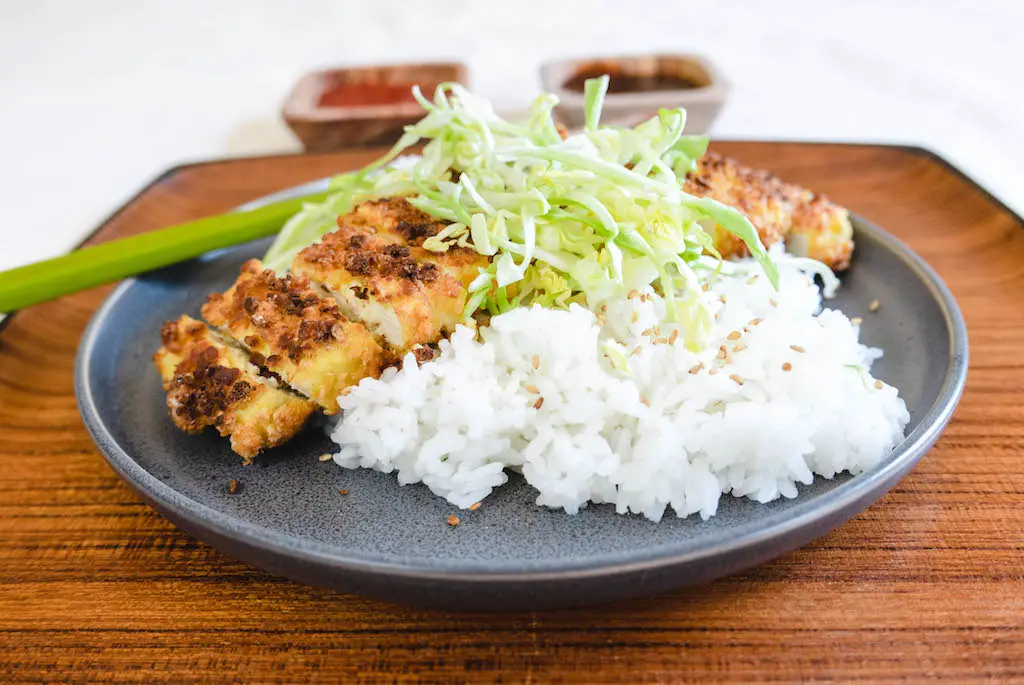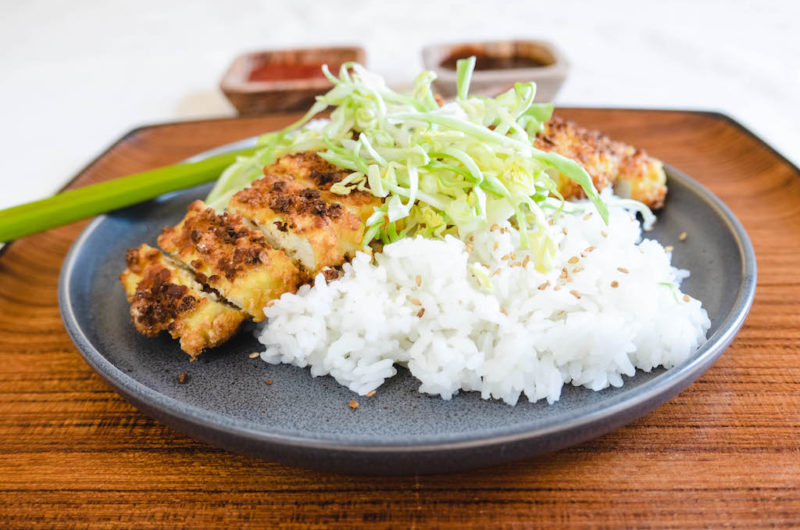This post may contain affiliate links. Please read my disclosure for details at the bottom of this page. As an Amazon Associate, I earn from qualifying purchases on this tofu katsu recipe. We hope you enjoy learning how to make this vegetarian Japanese tofu cutlet!
As someone with celiac disease, I am acutely aware of people’s dietary needs and restrictions. Whether it’s for religious, health, or ethical reasons, vegetarianism continues to rise in popularity as an alternative to the meat-eating lifestyle. As such, we decided to make a meatless version of one of our favorite Japanese foods, katsu, for our vegetarian friends! So, let’s learn how to make tofu katsu, otherwise known as a vegetarian version of the Japanese steak cutlet!
But, before getting into the recipe, let’s first learn a bit about Japanese katsu!
What Is Katsu?
Katsu is a style of Japanese dish made by coating different proteins, such as chicken, pork, and ham, in panko bread crumbs before frying the meat in oil.
The word katsu is a shortened form of the word katsuretsu, which translates from Japanese to English as ‘cutlet.’ So, the Japanese named this method of cooking based on the actual meat cut!
During your future travels to Japan, you may note that chicken and pork katsu are typically the most popular and readily available versions of this dish. While that may be the case, you can still find further variations on your travels!
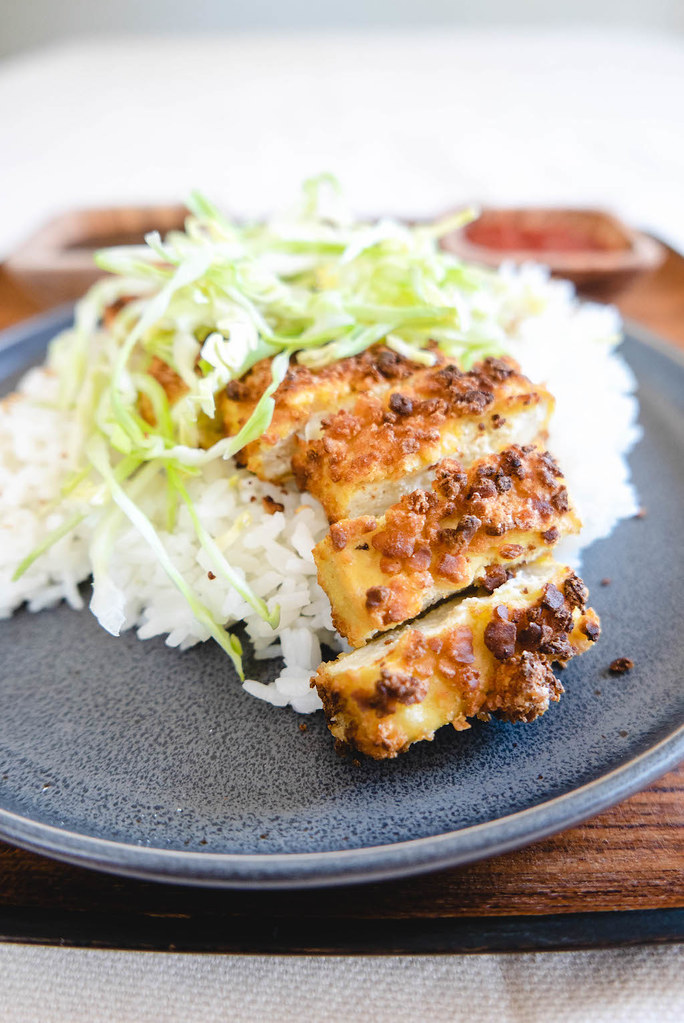
Types of Katsu:
- Chikinkatsu (チキンカツ) or Torikatsu (鶏カツ): Chicken Katsu
- Tonkatsu (豚カツ, とんかつ or トンカツ): Pork Katsu
- Hamu Katsu (ハムカツ): Ham Katsu
- Menchi Katsu (メンチカツ) or Minchi Katsu (ミンチカツ): Ground or Minced Meat Katsu
- Gyukatsu (牛カツ): Beef Steak Katsu
How Do People Serve Katsu?
In Japan, katsu is generally served with a tonkatsu sauce–a thick Japanese condiment made with Worcestershire sauce, ketchup, sugar, and soy sauce. Often, people in Japan serve the katsu and sauce with rice, shredded cabbage, and further sides such as miso soup or grated daikon radish.
Beyond the traditional way of eating katsu over rice, people in Japan and Hawaii have developed recipes with katsu as the main protein. Examples include:
- Katsukarē (カツカレー): Katsu Curry. A dish consisting of tonkatsu (pork cutlet) served with Japanese curry and rice.
- Katsudon (カツ丼): A rice bowl dish made with tonkatsu, egg, vegetables, and condiments. The dish’s name comes from two Japanese words: tonkatsu (pork cutlet) and donburi (rice bowl dish).
- Katsu Sando: Katsu sandwich. Often, these sandwiches are made with tonkatsu. The ‘tonkatsu sauce’ is often spread on the bread as the condiment.
- Cheese Katsu: A new popular version of katsu. Mozzarella cheese is placed in the center between two pieces of meat before they are breaded and fried. The cheese oozes out as you eat.
- And so on…
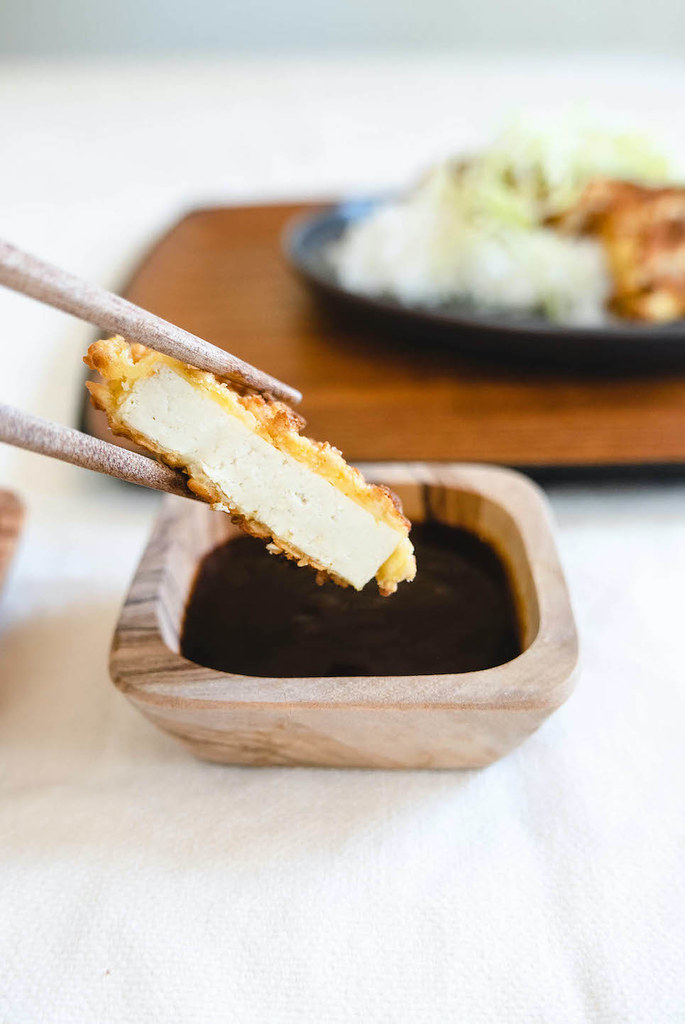
Fun Katsu Facts:
Below are some fun cultural facts about Japanese katsu!
- In recent years, it has become a tradition for Japanese students to eat katsudon the night before a major test or exam. The word ‘katsu’ is a homophone of the verb katsu (勝つ) which means ‘to win’ or ‘to be victorious.’
- In the United Kingdom, ‘katsu’ is synonymous with the Japanese curry cutlets instead of the breaded meat cutlets. Just make sure to check when ordering!
- Katsu was first invented in the 1800s. At the time, the Japanese considered the dish to be a Japanese version of western cuisine–it resembles the German schnitzel. Actually, the word ‘katsuretsu’ comes from the English word ‘cutlet!’

Tofu Katsu Tips and Tricks
- First, prep your tofu by pressing it for an extended period. I typically do this for an hour. Tofu contains a lot of liquid. You need to press out the liquid so the tofu can improve in texture, absorb the flavors you are cooking with, and for safety when frying (as oil and water react dangerously when combined with heat).
- For those, like me, who do not have a tofu press, place your drained tofu on top of a few layers of paper towels on a cutting board. Then, add a few more layers of paper towels and place something hard on top. I use my cast-iron skillet as a press!
- Deep-Frying Method: To deep-fry, fill a deep pot with oil. Then, let the oil reach between 350°F-375°F before lowering in the breaded tofu.
- Pan-Frying Method: For pan-frying, fill a wide and deep skillet with approximately ½-1 inch thick with oil. Let the oil reach between 350°F-375°F before placing your breaded tofu into the skillet. You will need to flip the tofu halfway through frying.
- Prep your ingredients by placing the cornstarch, eggs, and panko in three different bowls next to one another by the stove. That way, you can have an assembly line before adding the katsu onto the pan.
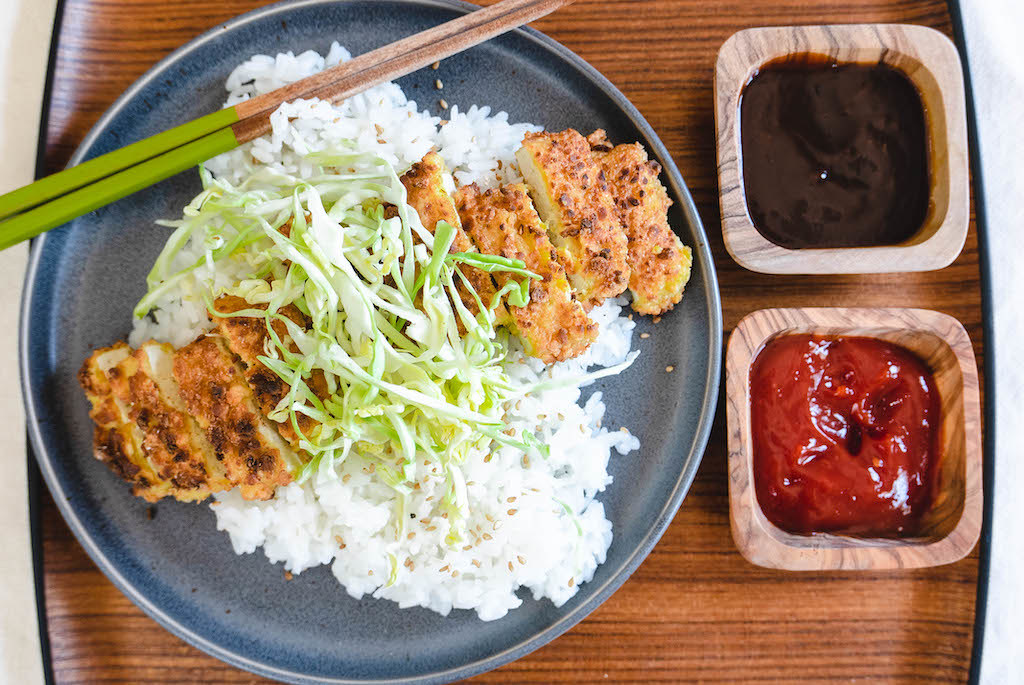
Below, we listed some items you may need to make our tofu katsu and tonkatsu sauce. These links are affiliate links we recommend!
Tofu Katsu Frequently Asked Questions
Below, we listed some questions you may have about this tofu katsu recipe. If we do not answer your question, feel free to leave a comment or email us at [email protected]!
Can You Make Tofu Katsu Gluten-Free?
Yes! You can make tofu katsu gluten-free. These days, many grocery stores and online retailers sell gluten-free panko! Our tofu katsu photographed is actually gluten-free.
How Should I Store Tofu If I Don’t Use the Entire Block?
If you do not use the entire tofu black, place the remaining tofu in an airtight container. Once you do that, fill the container with water until you fully submerge the tofu. Then, place it in the refrigerator. Tofu should be eaten within a few days after being opened.

How Should I Store Leftover Tofu Katsu?
Place your leftover tofu katsu in an airtight container and place it in the refrigerator. You should consume your leftovers within 1-2 days of cooking.
If you also made the tonkatsu sauce and have leftovers, place it in an airtight container in the refrigerator for up to a week!
How Should I Reheat Leftover Tofu Katsu?
I do not recommend reheating in the microwave. Unfortunately, reheating with that method makes the panko bread really soggy.
Instead, I recommend toasting the leftovers in the oven or toaster oven until warm. This allows the breading to crisp again and the tofu center to reheat. First, preheat your oven to 350°F. Then, cover a baking sheet with parchment. Finally, place your leftovers on the parchment and into the oven. Heat until the dish is warm again.
Note: Make sure to keep an eye on your food. You don’t want to burn the breading during the reheating process!

We Hope You Enjoyed Our Tofu Katsu Recipe!
In the end, do you enjoy eating different Japanese foods? If so, let us know your favorites! We would love to hear of any recommendations in the comment section!
If you would like to read more articles listing different types of delicious foods, check out our Carving A Journey recipe below!
Carving A Journey Food and Drink Recipes:
- Southern Deviled Eggs
- Kimchi Deviled Eggs
- Bibimmyeon (Spicy Korean Cold Noodles)
- Andong Jjimdak (Korean Braised Chicken)
- Mayak Eggs (Korean Marinated Eggs)
- Soju Caipirinha (A Korean Take on Brazil’s National Drink); And
- Korean Strawberry Milk Recipe
If you have any questions or comments, you can also email us at [email protected].
And, finally, we would love to hear from you through our social media as well! You can follow us at @carvingajourney on Instagram, Twitter, Facebook, and Pinterest. Or, if you would like more articles like these, you can subscribe to our blog by joining our mailing list. We hope you enjoyed our tofu katsu recipe! Thank you so much for stopping by!
Carving A Journey is a participant in the Amazon Services LLC Associates Program, an affiliate advertising program designed to provide a means for sites to earn advertising fees by advertising and linking to Amazon.com. Although we may earn commissions for our endorsement, recommendation, testimonial, and/or link to any products or services from this website, these opinions are my own and I fully support these products.

